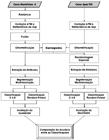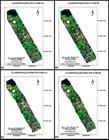Urban environments represent one of the most challenging areas for remote sensing analyses due to the great diversity of land cover materials found in their surface. The fusion of high spatial and high spectral resolution images arise as an alternative for urban applications, for the combination of these two characteristics allows better detection and discrimination of urban targets. The present work has a twofold objective: i) evaluate two datasets for the fine classification of urban targets at two levels of legend (with 11 and 38 land cover classes): one of them exclusively consisting of an orbital multispectral image (WV-2) and another one exclusively comprising an airborne hyperspectral image (SpecTIR), ii) as well as assess the performance of two different image classification methods, C4.5 Decision Tree and Random Forest, for both levels of legend. Eight classification experiments were executed to meet such objectives of investigating the efficacy of sensors and classification methods for the concerned two levels of detailing. The obtained classifications attained high accuracy. For all adopted levels of legend and methods, it was demonstrated that the classifications using SpecTIR data presented results significantly superior to those obtained with the WV-2 data
Keywords:
WorldView-2; ProSpecTIR V-S; Urban Land Cover Classification; Non-parametric Methods.

 Thumbnail
Thumbnail
 Thumbnail
Thumbnail
 Thumbnail
Thumbnail
 Thumbnail
Thumbnail
 Thumbnail
Thumbnail




